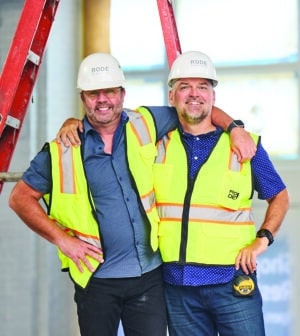Eric Robinson and Kevin Deabler
RODE Architects
Ages: 53 and 52
Industry experience: 30 years
As college classmates-turned-co-founders of Dorchester’s RODE Architects, Eric Robinson and Kevin Deabler have carved out a niche designing mid-sized projects in Boston’s neighborhoods. In recent years, the 19-year-old firm has designed notable projects ranging from Dorchester Brewing Co.’s brewhouse to West Roxbury’s Brucewood Homes, a trio of single-family houses that became Boston’s first to be certified for energy-saving Passive House construction standards. This spring, RODE acquired McMahon Architects to strengthen its workplace and hospitality design capabilities.
Q: How did your business partnership come together and what is the firm’s current growth strategy?
Deabler: We met each other as undergraduates at North Carolina State University in Raleigh and moved up to Boston at different times. The first business plan had a lot to do with pure survival. It was 2008 and we were starting to get a few small side projects while we managed our exits from our previous firms. Starting families and living in Dorchester, our feet were pretty fixed to the ground there where we settled and still live today: focusing on the needs of the neighborhood that surrounded us and having an idea that the neighborhood could be better in some manner. That was the basis and there were a lot of small housing projects.
Q: On the housing front, as projects become more difficult to finance, are clients asking you to redesign and value engineer projects?
Robinson: In some forms and fashions. The market is certainly challenging, while not similar to COVID, which was really a supply and commodity issue. Now, the cost to borrow is out of reach and projects are not penciling and not moving forward. There are some goals to make things more efficient and remove some things that were agreed upon. That’s certainly happening, but I don’t know if that really is pushing the projects over the top because the cost of money is still high. We really need a shift in the financial markets.
Q: How are developers adjusting to the new regulations and climate projections for coastal sites?
Deabler: Due to the city we are and its history, we start off on a basis where most of the land around our water has been developed previously. It is very much a part of the fabric of Boston. We’re into many years of knowing that for sites around the waterfront, you need to be sensitive to climate change and what it means for storm surges. And you can’t just forbid construction in those zones. They are already part of our city’s fabric. But I know that there are a lot of innovations in the way sites can be developed. When you have a site along the water, you have an opportunity to make it more resistant to storm surges and wave action and destructive forces. But we really need to pay attention to the 99 percent of the time people live along the water and just make it more accessible, reaching parts of the city that have seemingly been written off.
Robinson: The one thing that we are seeing is that while the waterfront is the most recognizable issue, we are seeing a lot of the issues associated with sites that would appear to be inland, that also are dealing with resiliency issues to raise the first floor or manage those issues for 100 years. It’s happening more and more throughout the city in low-lying areas such as South Boston: elevating the floor 4 and 5 feet from the street. It adds a wrinkle and complexity to dealing with the things we believe in: creating public realms and relationships to the streets.
Q: How is the acquisition of McMahon Architects adding to RODE’s capabilities?
Deabler: We completed it around June 1 and they add more energy. They add expertise in workplaces as well as retail, and quite a range of projects. There are a lot of similarities to our approaches. It’s the first time we’ve acquired a firm, so after understanding the financial status of projects, we’re beyond that stage and have learned a lot in the process and are in the process of executing on the promises of that deal.
Robinson: They are an interiors firm, so they’ve brought in a lot of great new opportunities in helping us with placemaking and creating workplace and hospitality environments that have given some additional expertise to our own interiors group. Plus, we are one floor separated from one another at 535 Albany St., so everyone knows how to get to the office.
Q: How is your firm approaching the role of AI in architecture?
Deabler: I know that some of our communications are sped up by summarizing notes. Our rendering capabilities are much faster now. It creates a dynamic with our clients on managing expectations. You can create such realistic renderings, delivering on them is probably the harder part.
Deabler’s Five Favorite Tools
- 5-ton mini-excavator
- Dewalt multi-tool
- Milwaukee Sawzall
- Framing square
- 21-inch Stihl chainsaw
Robinson’s Five Favorite Boston Wild Places to Get Lost In
- Dorchester Park, Dorchester
- Peddocks Island, Boston Harbor
- Franklin Park
- Millennium Park, West Roxbury
- Olmsted Park, Jamaica Plain








